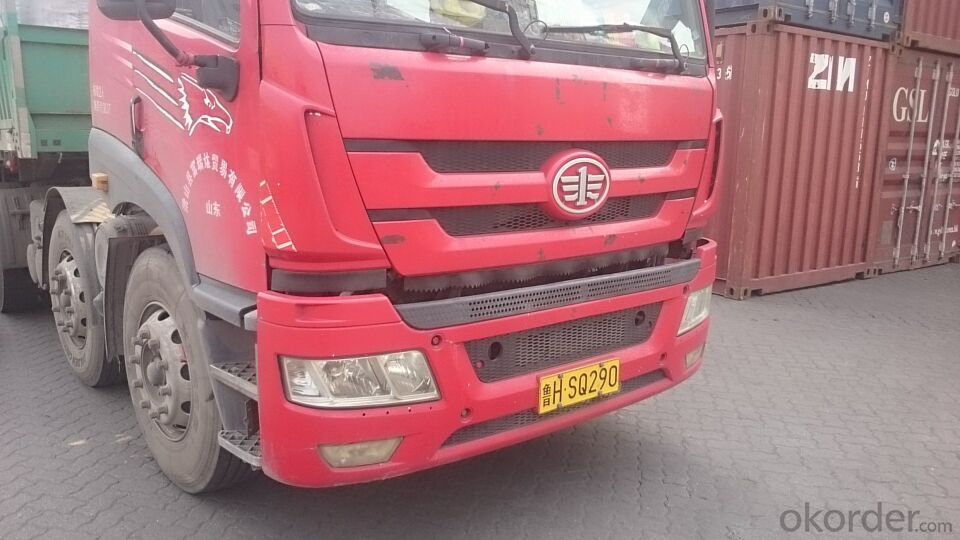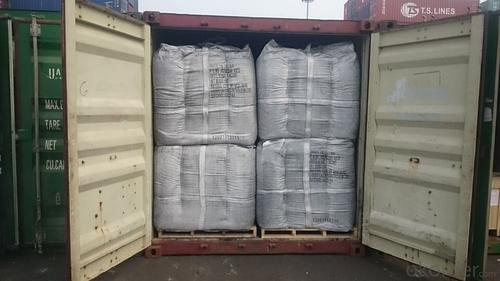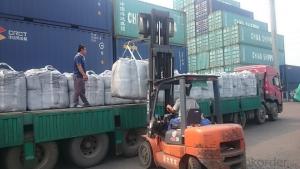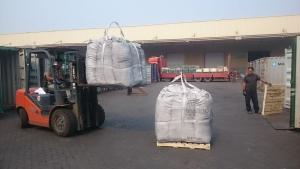Used in EAF as Charge Coke for Steel Mills with VM 2%max
- Loading Port:
- Tianjin
- Payment Terms:
- TT OR LC
- Min Order Qty:
- 21 m.t.
- Supply Capability:
- 6000 m.t./month
OKorder Service Pledge
OKorder Financial Service
You Might Also Like
Introduction:
Calcined anthracite can be called carbon additive, carbon raiser, recarburizer, injection coke, charging coke, gas calcined anthracite.
Carbon Additive/Calcined Anthracite Coal may substitute massively refinery coke or graphite. Meanwhile its cost is much less than the refinery coke and graphite. Carbon Additive is mainly used in electric steel ovens, water filtering, rust removal in shipbuilding and production of carbon material.
It has good characteristics with low ash, low resistivity, low sulphur, high carbon and high density. It is the best material for high quality carbon products. It is used as carbon additive in steel industry or fuel.
Features:
Best quality Taixi anthracite as raw materials through high temperature calcined at 800-1200 ℃ by the DC electric calciner with results in eliminating the moisture and volatile matter from Anthracite efficiently, improving the density and the electric conductivity and strengthening the mechanical strength and anti-oxidation, It has good characteristics with low ash, low resistivity, low carbon and high density. It is the best material for high quality carbon products, it is used as carbon additive in steel industry or fuel.
Specifications:
F.C.% | 95MIN | 94MIN | 93MIN | 92MIN | 90MIN | 85MIN | 84MIN |
ASH % | 4MAX | 5MAX | 6 MAX | 6.5MAX | 8.5MAX | 12MAX | 13MAX |
V.M.% | 1 MAX | 1MAX | 1.0MAX | 1.5MAX | 1.5MAX | 3 MAX | 3 MAX |
SULFUR % | 0.3MAX | 0.3MAX | 0.3MAX | 0.35MAX | 0.35MAX | 0.5MAX | 0.5MAX |
MOISTURE % | 0.5MAX | 0.5MAX | 0.5MAX | 0.5MAX | 0.5MAX | 1MAX | 1MAX |
Pictures




FAQ:
Packing:
(1). Waterproof jumbo bags: 800kgs~1100kgs/ bag according to different grain sizes;
(2). Waterproof PP woven bags / Paper bags: 5kg / 7.5kg / 12.5kg / 20kg / 25kg / 30kg / 50kg small bags;
(3). Small bags into jumbo bags: waterproof PP woven bags / paper bags in 800kg ~1100kg jumbo bags.
Payment terms
20% down payment and 80% against copy of B/L.
Workable LC at sight,
- Q: What are the industrial uses of diamonds?
- Diamonds have a wide range of industrial uses due to their exceptional physical properties. One of the most common industrial uses of diamonds is in the manufacturing of cutting and grinding tools. Diamond-tipped saw blades, drill bits, and grinding wheels are highly sought after for their superior hardness and abrasion resistance. These tools are used to cut and shape hard materials like concrete, ceramics, and metals. Diamonds also find extensive applications in the electronics industry. They are used as heat sinks in high-power electronic devices and as abrasive materials for polishing and lapping electronic components. The thermal conductivity of diamonds allows them to efficiently dissipate heat, making them ideal for electronic devices that generate a lot of heat during operation. Furthermore, diamonds are used in the production of specialized windows, lenses, and prisms for various scientific and industrial applications. Their optical properties, such as high refractive index and low dispersion, make them valuable for creating precision optics used in lasers, spectroscopy, and telecommunications. In addition, diamonds have found niche uses in the medical and dental fields. They are used in surgical tools such as scalpels and dental drills due to their exceptional hardness and ability to retain sharp edges. Diamond coatings are also applied to medical implants and prosthetics to improve their wear resistance and biocompatibility. Lastly, diamonds are utilized in the oil and gas industry for drilling and exploration purposes. Diamond drill bits are capable of penetrating extremely hard rock formations, making them essential for extracting oil and natural gas from deep beneath the Earth's surface. Overall, the industrial uses of diamonds are vast and diverse, ranging from cutting and grinding tools to electronics, optics, medicine, and even oil and gas exploration. The unique properties of diamonds make them indispensable in numerous industrial applications, contributing to advancements in various fields.
- Q: What is the carbon emission of the air conditioner?
- Summer, less air-conditioning, 1 hours to reduce carbon emissions of 0.621kg, the action of the low carbon family is not how much money you need to pay, but to change some of your habits and habits, and contribute to environmental protection. Hand in hand to join hands to tackle climate warming, perhaps our hearts will be less worried about the future......
- Q: What are the consequences of increased carbon emissions on vulnerable communities?
- Vulnerable communities bear the brunt of severe consequences caused by the increase in carbon emissions. To begin with, these communities lack the necessary resources and infrastructure to adapt to and alleviate the impacts of climate change. The contribution of carbon emissions to global warming makes it more likely for these communities to experience extreme weather events, such as hurricanes, floods, and heatwaves. Consequently, displacement, loss of homes, and even loss of lives disproportionately affect those who are already marginalized. Moreover, the rise in carbon emissions leads to air pollution, which poses significant health risks to vulnerable communities. Inhabitants of low-income areas often reside in close proximity to industrial plants or highways with high emission levels, increasing their vulnerability to respiratory diseases, cardiovascular problems, and other health issues. This is particularly true for children, the elderly, and individuals with pre-existing health conditions. The consequences of increased carbon emissions also extend to food security. Climate change disrupts agriculture and alters the timing of growing seasons, resulting in reduced crop yields and food shortages. Vulnerable communities heavily dependent on subsistence farming or residing in areas prone to droughts or floods are at risk of malnutrition and hunger. This further aggravates existing inequalities and can lead to social unrest and economic instability. Furthermore, vulnerable communities often rely on natural resources, such as fishing, forestry, or tourism, for their livelihoods. The negative impacts of carbon emissions, such as ocean acidification and coral bleaching, jeopardize these industries, leading to job losses and economic decline. This perpetuates the cycle of poverty and socio-economic vulnerability. In conclusion, increased carbon emissions disproportionately harm vulnerable communities by exacerbating existing inequalities and intensifying the challenges they face. It is crucial to address these consequences through climate mitigation efforts, adaptation strategies, and support for sustainable development.
- Q: How do carbon emissions contribute to extreme weather events?
- Extreme weather events are influenced by carbon emissions, which contribute to climate change. When greenhouse gases like carbon dioxide are released into the atmosphere, they trap heat from the sun and cause the Earth's average temperature to rise. Human activities such as burning fossil fuels, deforestation, and industrial processes are major drivers of this phenomenon known as global warming. As the planet warms, weather patterns become disrupted, leading to an increase in extreme weather events. Carbon emissions play a role in this process in several ways: 1. Heatwaves: Higher carbon emissions result in increased temperatures, leading to more frequent and intense heatwaves. These prolonged periods of extreme heat pose risks to human health, agriculture, and ecosystems. 2. Hurricanes and tropical storms: Carbon emissions cause ocean temperatures to rise, providing more energy to fuel hurricanes and tropical storms. This leads to stronger storms with higher wind speeds and heavier rainfall, causing more destruction and flooding. 3. Droughts: Climate change caused by carbon emissions can disrupt precipitation patterns, resulting in decreased rainfall and increased droughts in certain regions. These prolonged periods of water scarcity have severe impacts on agriculture, water supplies, and ecosystems. 4. Heavy rainfall and flooding: Global warming intensifies the water cycle, leading to more evaporation and moisture in the atmosphere. This results in heavier rainfall events, increasing the risk of flooding and flash floods. 5. Wildfires: Climate change, driven by rising temperatures and drier conditions, creates favorable conditions for wildfires. Carbon emissions contribute to longer and more severe fire seasons, leading to more extensive and destructive wildfires. It's important to note that while carbon emissions contribute to extreme weather events, they are not the sole cause. Natural climate variability factors like El Niño and La Niña can also influence extreme weather. However, reducing carbon emissions and transitioning to cleaner energy sources can help mitigate the impacts of climate change and prevent further exacerbation of extreme weather events.
- Q: What are the impacts of carbon emissions on biodiversity?
- Carbon emissions have significant impacts on biodiversity. Increased levels of carbon dioxide in the atmosphere contribute to climate change, which disrupts ecosystems and threatens biodiversity. Rising temperatures, altered precipitation patterns, and more frequent extreme weather events can lead to habitat loss, shifts in species distribution, and reduced reproductive success. Moreover, ocean acidification resulting from carbon emissions poses a threat to marine ecosystems, affecting coral reefs and other vulnerable species. Overall, carbon emissions have detrimental effects on biodiversity, potentially leading to the extinction of numerous species and the destabilization of ecosystems.
- Q: What are the consequences of increased carbon emissions on cultural heritage sites?
- Increased carbon emissions can have severe consequences on cultural heritage sites. The most immediate impact is climate change, which leads to rising sea levels, more frequent and intense natural disasters, and changes in temperature and precipitation patterns. These changes can directly damage or destroy cultural heritage sites, including archaeological sites, historic buildings, and monuments. Additionally, increased carbon emissions contribute to air pollution, leading to acid rain and atmospheric pollutants that can erode and deteriorate cultural artifacts. Furthermore, climate change can disrupt local communities and economies that depend on these heritage sites for tourism, resulting in a loss of cultural identity and economic decline. Overall, the consequences of increased carbon emissions on cultural heritage sites are both tangible and intangible, threatening our shared history and cultural diversity.
- Q: Is the hardness or softness of the steel with higher carbon content?
- With the increase of carbon content, the strength and hardness of steel increase, while the plasticity and toughness decrease. When the carbon content is more than 1%, the strength of steel decreases.
- Q: What is carbon nanowire?
- Carbon nanowire is a nanoscale structure composed of carbon atoms arranged in a wire-like shape, which exhibits exceptional electrical, thermal, and mechanical properties.
- Q: How does carbon affect the formation of blizzards?
- Blizzards, characterized by strong winds, low temperatures, and heavy snowfall, are not directly affected by carbon. Blizzards typically occur when a low-pressure system moves into an area with enough moisture and cold air. Temperature, moisture, and wind patterns are the main factors that influence the formation of blizzards. Nevertheless, carbon emissions and their impact on the climate can indirectly affect the frequency and intensity of blizzards. Carbon dioxide (CO2) and other greenhouse gases trap heat in the atmosphere, causing global warming. This warming effect can change weather patterns, including the conditions required for blizzard formation. Carbon emissions can lead to warmer temperatures, altering precipitation patterns and increasing moisture in the atmosphere. This additional moisture, along with the necessary cold air, can contribute to heavier snowfall during blizzards. Furthermore, climate change can influence wind patterns, impacting the intensity and duration of blizzards. Changes in atmospheric circulation patterns can modify the tracks and strength of storms, potentially resulting in more or fewer blizzard events in specific regions. It is worth noting that the specific impact of carbon emissions on blizzard formation varies depending on regional and local factors. The intricate nature of weather systems and the interaction between different variables make it difficult to attribute any single weather event solely to carbon emissions. However, the overall influence of carbon emissions on the climate system increases the potential for more extreme weather events, including blizzards.
- Q: Carbon Finance: Carbon Finance
- Carbon finance does not have a unified concept. Generally speaking, it refers to all financial activities that serve to limit greenhouse gas emissions, including direct investment and financing, carbon index trading and bank loans. The rise of "carbon finance" stems from changes in international climate policy and, precisely, two international conventions of great significance - the United Nations Framework Convention on climate change and the Kyoto protocol. Carbon finance definition: improved use of financial capital to drive the environmental rights and interests, to the laws and regulations for support, the use of financial means in the market platform makes carbon financial products and derivatives trading or to circulation, and eventually achieve a low-carbon development, green development and sustainable development objective. The United Nations Conference on environment and Development held in June 1992 in Brazil, Rio De Janeiro, more than 150 countries have established the "United Nations Framework Convention on climate change" (United Nations Framework Convention on Climate Change, referred to as the "Framework Convention"). The ultimate goal of the Convention is to stabilize atmospheric concentrations of greenhouse gases at levels that do not harm the climate system.
Send your message to us
Used in EAF as Charge Coke for Steel Mills with VM 2%max
- Loading Port:
- Tianjin
- Payment Terms:
- TT OR LC
- Min Order Qty:
- 21 m.t.
- Supply Capability:
- 6000 m.t./month
OKorder Service Pledge
OKorder Financial Service
Similar products
Hot products
Hot Searches


























